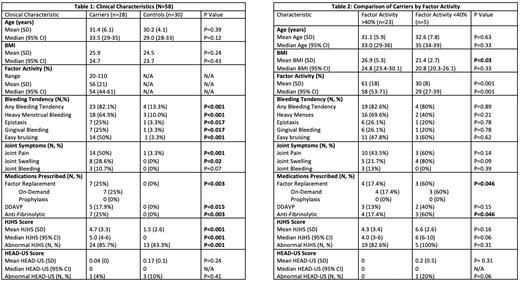Introduction: Women with hemophilia (WWH) are at risk for bleeding despite normal or mildly reduced plasma factor VIII (FVIII) or IX (FIX) activity levels. Subclinical joint bleeds can contribute to longstanding and irreversible joint damage. Although joint health has been well-studied among men with hemophilia, there is currently a gap in knowledge on the prevalence, clinical characteristics, and natural history of joint health in women with hemophilia. No prior studies have utilized point-of-care musculoskeletal ultrasound (POC-MSKUS) to assess the presence and characteristics of joint changes in carrier women.
Aim: This multi-institutional, cross-sectional study primarily aimed to evaluate and compare the prevalence and extent of joint-related symptoms and joint changes in WWH compared to age-matched controls utilizing validated clinical tools including the Hemophilia Early Arthropathy Detection with Ultrasound (HEAD-US) protocol. We also aimed to examine the relationship between innate FVIII and FIX levels and presence of joint disease changes in this population.
Methods: Between 2017-2023, women aged 18 to 40 years were enrolled and divided in 2 cohorts. The “carrier cohort” included women with a confirmed hemophilia A or B diagnosis, regardless of factor activity level. The “control cohort” included women without personal or family history of a bleeding disorder. Individuals were excluded if they had history of joint trauma or surgery within 12 months prior to enrollment or any history of joint replacement. Collected clinical information included presence of bleeding symptoms, joint-related symptoms, and historical use of hemostatic medications. Participants underwent clinical and radiological assessment of bilateral elbows, knees, and ankles using the Hemophilia Joint Health Score (HJHS) and HEAD-US protocol. Factor activity levels were measured in the carrier cohort. Descriptive and interferential statistics were performed using SPSS software with p<0.05 considered statistically significant.
Results: Fifty-eight women, including 30 controls (51.7%) and 28 carriers (48.3%) were enrolled. The mean age at enrollment was 30.7 years (range: 19-39 years). Most women were White (79.3%) and Hispanic (51.7%). Of the 28 carriers, 85.6% (n=24) were hemophilia A carriers and 14.3% (n=4) hemophilia B carriers, respectively ( TABLE 1). Among carriers, the mean and median factor activity levels were 56% and 54% (range 20-120%) respectively.
Carriers reported significantly higher prevalence of bleeding symptoms when compared to controls, including heavy menstrual bleeding (64.3% vs. 10%, p<0.001), epistaxis (25% vs. 3.3%, p=0.017), gingival bleeding (25% vs. 3.3%, p=0.017), and easy bruising (50% vs. 3.3%, p<0.001). The majority (53.5%, n=15) of carriers reported presence of joint-related symptoms when compared to controls, including joint pain (50% vs. 3.3%, p<0.001) and joint swelling (28.6% vs. 0%, p=0.02). Three (10.7%) carriers reported history of overt joint bleeds. Carriers had significantly higher mean HJHS scores (4.7 vs. 1.5, p<0.001) than did controls, however no significant changes in HEAD-US scores were found. A high body mass index (BMI) (>25kg/m2) was significantly associated with an increased prevalence of joint bleeding (25% vs. 0%, p=0.03) among carriers.
When dividing carriers in 2 groups based on their baseline factor activity level (>40% versus <40%), the prevalence of bleeding manifestations and joint-related symptoms were similar ( TABLE 2). Carriers with factor levels <40% were more likely to require factor replacement on-demand (60% vs. 17.4%, p=0.046) and anti-fibrinolytics (60% vs. 17.4%, p=0.046) than carriers with factor levels >40%. There were no changes in mean HJHS or mean HEAD-US scores among the two groups.
Conclusions: Women with hemophilia are at increased risk of bleeding manifestations and joint-related symptoms, regardless of factor activity levels. This population also seems to have poorer joint health than do non-carrier women as assessed by HJHS. Dedicated follow-up to help prevent and treat joint-related complications among WWH seems imperative. Our study did not detect significant ultrasonographic joint changes in the carrier cohort. However, joint findings may become more evident later in life or when assessed with magnetic resonance imaging. Further long-term studies are needed to support our hypothesis.
Disclosures
Kronenfeld:Bayer Healthcare Pharmaceuticals: Research Funding. Kempton:Pfizer: Honoraria; Takeda: Honoraria; Spark Therapuetics: Honoraria; Sanofi US: Honoraria; Genetech: Honoraria; BioMarin: Honoraria. Davis:Genentech: Honoraria; Spark Therapeutics: Consultancy, Honoraria, Membership on an entity's Board of Directors or advisory committees, Other: Speaker; Sanofi Genzyme: Consultancy, Honoraria, Membership on an entity's Board of Directors or advisory committees, Other: Speaker, Speakers Bureau. Corrales-Medina:Bayer: Other: Scientific advisory board, Research Funding; CSL Behring: Other: Scientific advisory board; Genentech: Other: Scientific advisory board; Octapharma: Other: Scientific advisory board; Takeda: Other: Scientific advisory board.


